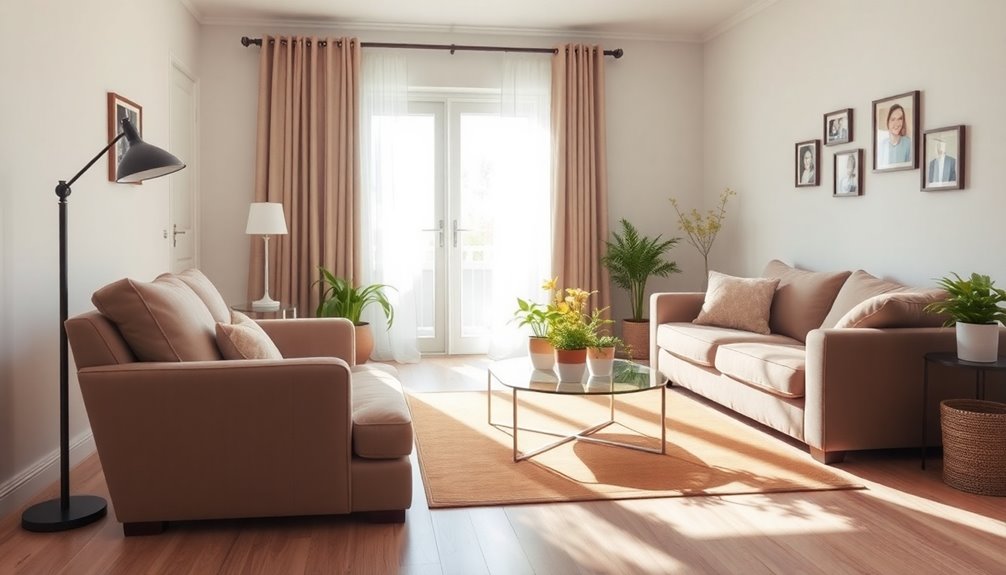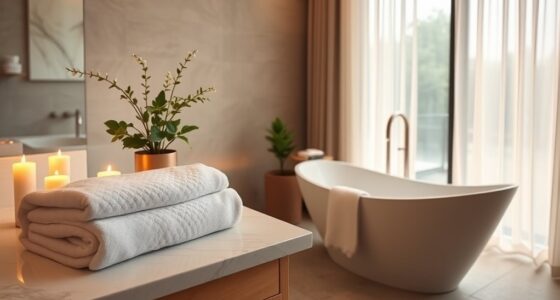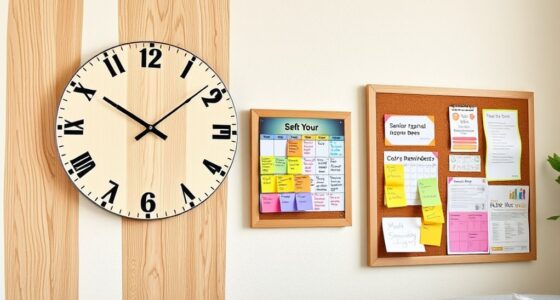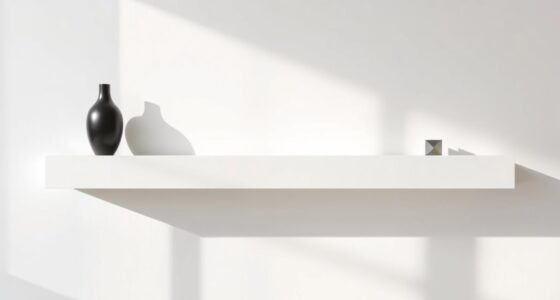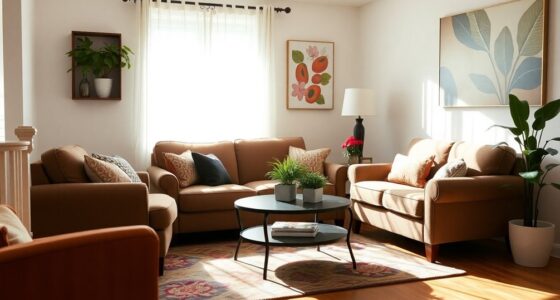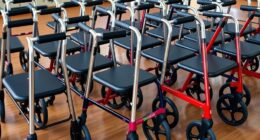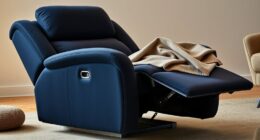To create an elderly-friendly home, focus on non-slip flooring to prevent falls, bright lighting for visibility, and clear pathways to enhance mobility. Choose multifunctional furniture that promotes comfort and ease of use. Install strategically placed grab bars for safety, and opt for soft color palettes that create a soothing atmosphere. Incorporate natural elements and smart home technology for added convenience. Adapt bathroom designs for accessibility, and you'll be well on your way to a welcoming space. Discover more ideas ahead!
Key Takeaways
- Use non-slip flooring options like textured vinyl and flamed granite to enhance safety and reduce fall risks in high-traffic areas.
- Incorporate bright, glare-free lighting solutions with motion sensors to improve visibility and safety in entryways and hallways.
- Choose multifunctional furniture with supportive seating to enhance comfort and usability for seniors while maximizing space efficiency.
- Design clear pathways with rounded furniture edges to minimize tripping hazards and facilitate easier movement for those with mobility aids.
- Opt for soft color palettes and contrasting colors to create a calming environment that improves visibility and reduces visual strain for aging eyes.
Non-Slip Flooring Options for Safety
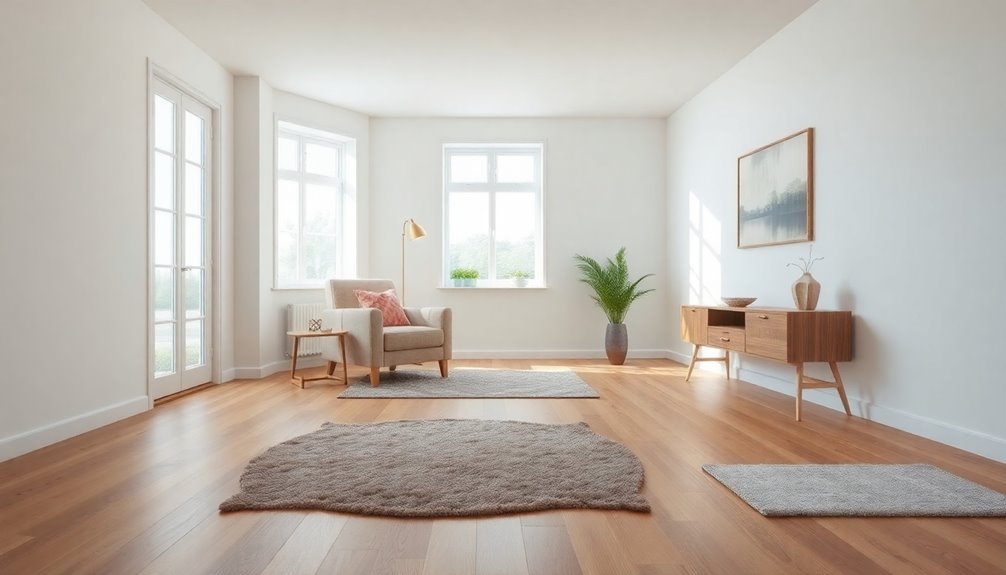
When it comes to creating a safe home environment for elderly individuals, choosing the right flooring is essential.
Opting for non-slip surfaces like textured vinyl or flamed granite can greatly reduce the risk of slips and falls, especially in high-risk areas such as bathrooms.
Anti-skid tiles are perfect for kitchens and hallways, combining safety with easy maintenance to help prevent accidents.
While carpeting offers comfort, it's often unsuitable for wheelchair users and can be difficult to clean, making it less ideal.
Consider flooring with a cork layer, which provides cushioning for falls and enhances non-slip features.
Ensuring all flooring types are easy to clean will also help maintain an organized and hazard-free living space for seniors. Additionally, incorporating air purifiers can further enhance indoor air quality, promoting a healthier environment for elderly residents.
Bright and Accessible Lighting Solutions
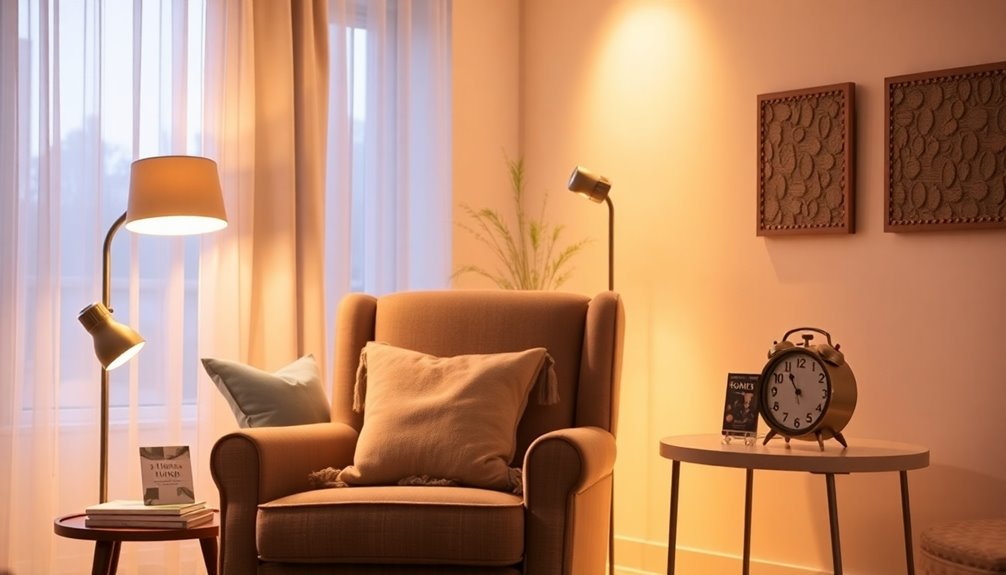
To guarantee a safe and welcoming environment for elderly residents, it is vital to prioritize bright and accessible lighting solutions throughout the home. Install bright, glare-free fixtures in high-traffic areas to enhance visibility and prevent accidents. Use motion-sensor lights for entryways and hallways, ensuring safety when entering or exiting. Task lighting in kitchens and bathrooms is important for aiding specific activities, enhancing bathroom safety, and reducing strain on aging eyes. Notably, a well-lit environment can also improve the effectiveness of HEPA filtration by reducing allergens that may be stirred up in poorly lit areas.
| Type of Lighting | Benefits | Recommended Areas |
|---|---|---|
| Ambient | Overall illumination | Living rooms, bedrooms |
| Task | Focused light for activities | Kitchens, bathrooms |
| Accent | Decorative and safety features | Hallways, entrances |
A well-lit environment boosts comfort and safety, addressing the needs of aging residents.
Clear Pathways and Open Spaces

To create a safe and inviting home, you need to minimize clutter and optimize your floor plan.
Clear pathways make navigation easier for you or loved ones using mobility aids. Additionally, ensuring that the home is equipped with proper heat pump efficiency can create a comfortable living environment year-round.
Minimize Clutter Effectively
Creating a safe and inviting home means prioritizing clear pathways and open spaces, especially for elderly residents. Minimizing clutter is essential to prevent tripping hazards and enhance mobility, allowing seniors to navigate their surroundings with ease.
Here are some effective strategies you can implement:
- Designate specific storage solutions for frequently used items
- Use multifunctional furniture, like storage ottomans
- Regularly assess and remove unnecessary items
- Keep floors clear of obstacles and loose rugs
- Organize spaces to promote a serene environment
These home modifications not only create a clutter-free atmosphere but also foster a sense of calm.
Optimize Floor Plans
An inviting and safe home for elderly residents requires not just minimizing clutter but also optimizing floor plans. To achieve this, guarantee clear pathways with a minimum width of 5 ½ to 6 feet, allowing mobility aids to navigate easily.
Open spaces reduce obstacles, enhancing accessibility and lowering the risk of trips and falls while aging in place. Consider eliminating excessive furniture and decor to create a more spacious environment that promotes easier movement.
Integrating design elements like rounded furniture edges and low-profile designs can prevent injuries from accidental bumps. Additionally, incorporating no-step entrances and ramps guarantees that your home accommodates residents with mobility challenges, making their living space more inviting and functional.
Ensure Easy Navigation
Guaranteeing easy navigation in a home for elderly residents hinges on maintaining clear pathways and open spaces.
A well-designed layout serves as a vital safety feature, helping to prevent accidents and falls.
To create an accessible environment, consider these tips:
- Maintain pathways at least 5 ½ to 6 feet wide for mobility aids.
- Remove clutter and excess furniture to create open spaces.
- Minimize flooring changes to avoid tripping hazards.
- Ascertain all entryways and hallways are well-lit for better visibility.
- Arrange furniture intuitively to support easy movement and reduce confusion.
Additionally, incorporating natural materials can enhance the comfort and warmth of the space, making it feel more inviting for residents.
Multifunctional and Comfortable Furniture
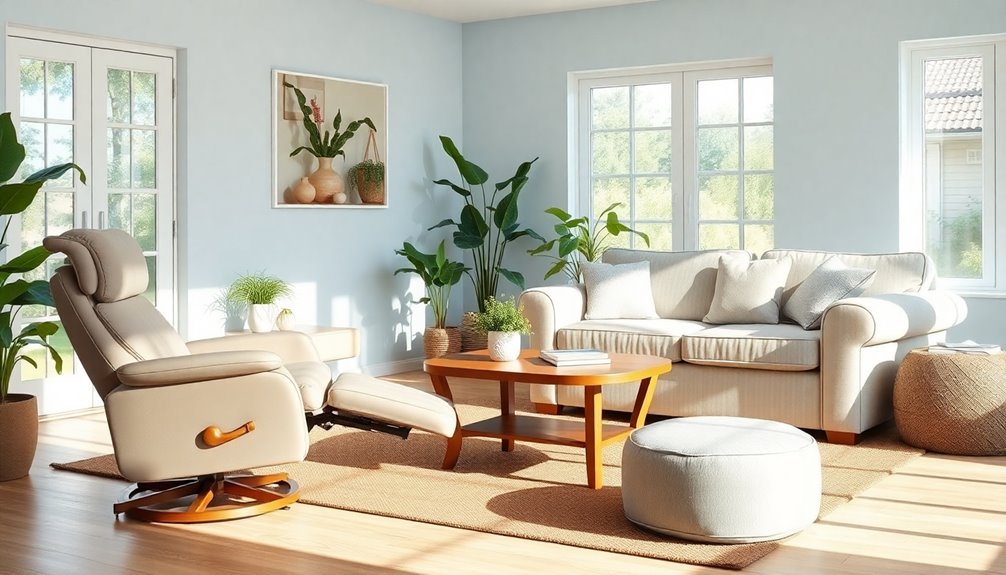
When choosing furniture for elderly-friendly spaces, think about multifunctional designs that save space and offer easy operation.
Supportive seating options, like reclining chairs and adjustable tables, provide comfort while accommodating various mobility needs. Additionally, consider incorporating calming environments to enhance relaxation and reduce anxiety during the evening hours.
Space-saving Designs
As you design an elderly-friendly home, consider incorporating space-saving solutions that blend multifunctionality with comfort.
These designs not only enhance your space but also support maintaining independence for older adults. Here are some ideas to get you started:
- Sofas that convert into beds for guests
- Storage ottomans that double as seating
- Adjustable-height tables for various activities
- Benches with hidden compartments for extra storage
- Lightweight furniture for easy rearrangement
Incorporating natural materials can also create a calming atmosphere that promotes relaxation and well-being.
Easy-to-Operate Mechanisms
To create a truly elderly-friendly home, it's essential to prioritize easy-to-operate mechanisms in furniture design. These features enhance usability, allowing seniors to age in place comfortably. Lever-style handles and remote-controlled options minimize effort, while multifunctional furniture—like lift-top coffee tables and adjustable-height desks—offers flexibility for various tasks. Comfort-focused designs, such as ergonomic chairs and recliner sofas, guarantee better posture and customizable comfort levels. Additionally, built-in storage solutions help keep essentials within reach, promoting organization. Incorporating multifunctional furniture can further streamline living spaces, ensuring that seniors have what they need at their fingertips.
| Furniture Type | Easy-to-Operate Mechanism |
|---|---|
| Lift-top coffee table | Simple lever for lifting |
| Adjustable-height desk | Easy-to-turn knobs or buttons |
| Recliner sofa | Remote control or lever handle |
| Ergonomic chair | Simple height adjustment lever |
| Storage ottoman | Top opens with minimal effort |
Supportive Seating Options
Supportive seating options play an essential role in creating a comfortable and functional living space for seniors.
When designing your home for older adults, consider these key features:
- Seat height: Aim for 18 to 21 inches to ease sitting and standing.
- Armrests: Provide essential support to reduce fall risks.
- Firm cushions: Help seniors rise with minimal effort.
- Multifunctional furniture: Opt for ottomans with storage or convertible sofas to maximize space.
- Recliners: Look for adjustable backrests and footrests to improve circulation.
- Incorporating smart home devices can enhance the safety and convenience of supportive seating options.
Strategically Placed Grab Bars
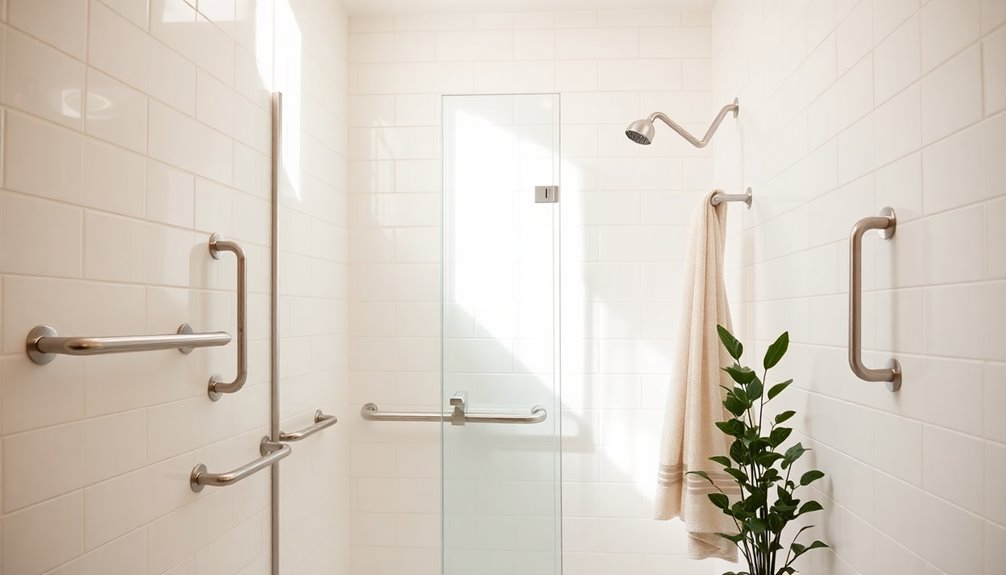
Installing strategically placed grab bars can greatly enhance safety in your home, especially in areas like the bathroom where falls are most likely to occur.
For senior citizens, having grab bars securely bolted into wall studs is essential for maximum stability. Aim for a height of 33 to 36 inches from the floor to accommodate individuals of varying heights.
It's wise to install grab bars near the toilet, inside and outside the shower, and next to bathtubs. Choose bars with a non-slip surface and a comfortable grip diameter, making them easier to hold for those with limited hand strength.
Don't forget to conduct regular inspections to verify they remain secure and functional over time. Additionally, consider consulting with healthcare professionals to ensure that the installation meets the specific safety needs of the elderly individuals in your home.
Accessible Storage Solutions
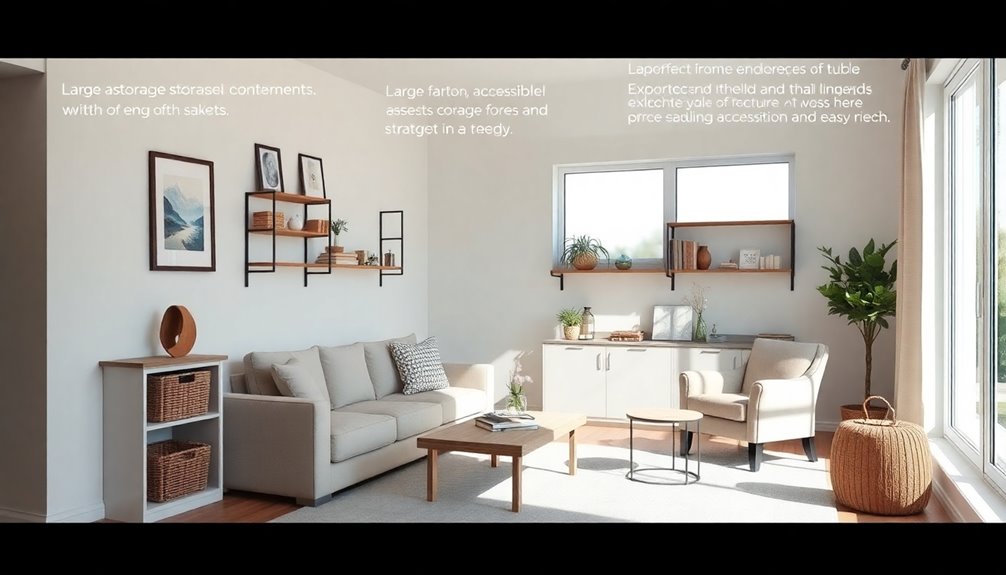
Creating a safe and comfortable environment for seniors goes beyond grab bars; accessible storage solutions play an essential role too. By implementing smart storage options, you can help older adults with arthritis or limited hand mobility navigate their homes more easily.
- Utilize lower countertops and pull-out shelves to minimize bending.
- Incorporate adjustable-height storage solutions like step stools with handrails.
- Design closets with lower rods and easy-to-open doors.
- Install clear labeling on storage bins and shelves for better identification.
- Use open shelving or glass-front cabinets to enhance visibility and reduce clutter.
These changes promote independence and make daily activities less challenging, ensuring your loved ones can access what they need without straining or risking injury. Additionally, creating consistent routines can further support their emotional well-being during times of transition.
Soft and Inviting Color Palettes
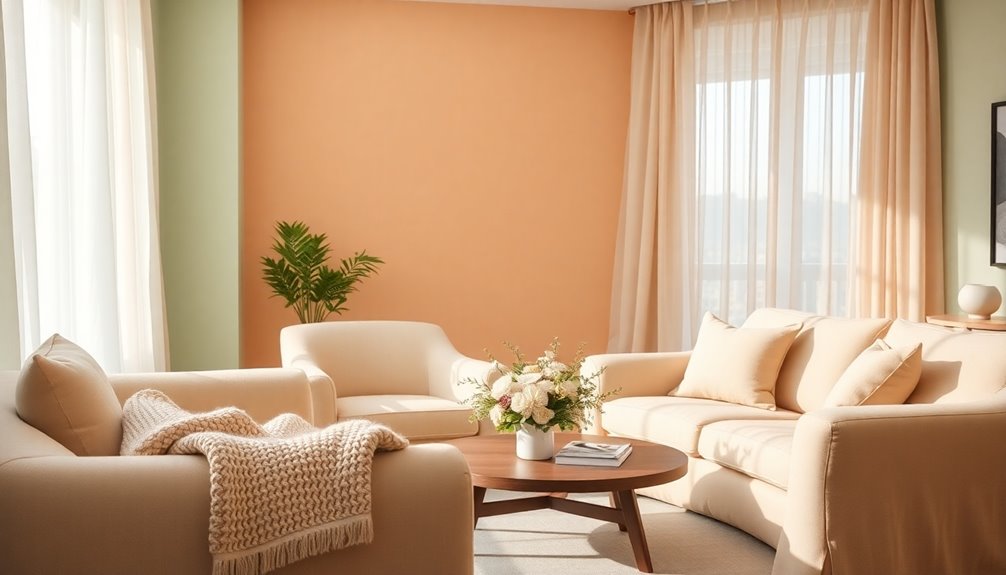
Color plays an essential role in shaping the atmosphere of a home, especially for elderly residents. By using soft and inviting color palettes, like light blues, soft greens, and warm neutrals, you can create a calming environment that promotes relaxation.
These hues not only enhance natural light but also make spaces feel larger and more cheerful, boosting mood and mental health. Consider colors that contrast with flooring and furniture to improve visibility and navigation, reducing the risk of accidents.
Warm tones evoke feelings of coziness, creating a comforting homelike atmosphere. Additionally, soft palettes minimize visual strain, making it easier for aging eyes to perceive details and navigate spaces effectively.
Embrace these ideas in your interior design for an elderly-friendly home.
Incorporating Natural Elements
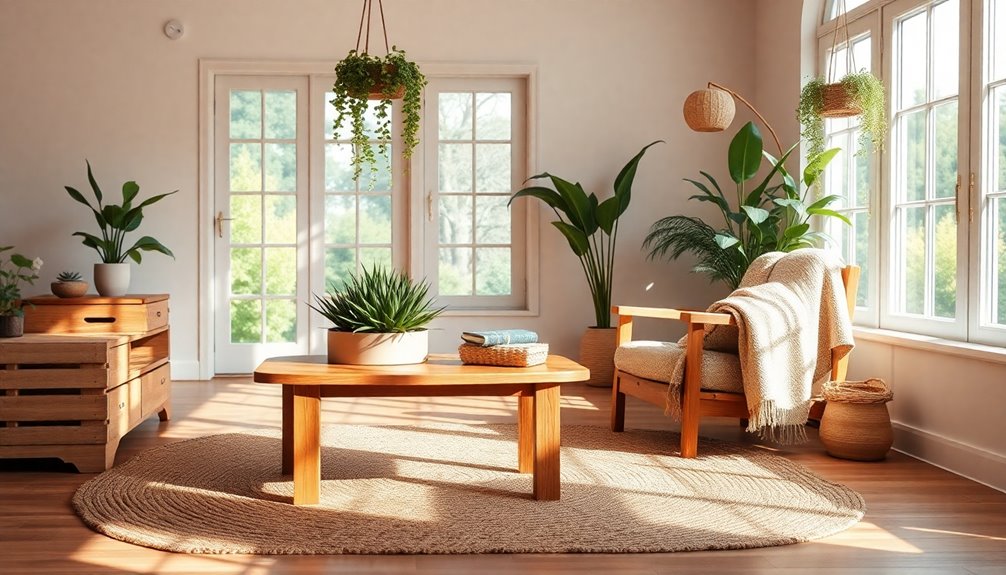
Soft and inviting color palettes set a serene foundation, but adding natural elements can elevate that calming atmosphere even further.
Incorporating biophilic design into your home enhances aesthetics and promotes well-being for elderly residents. Here are some ways to bring nature indoors:
- Use natural materials like wood and stone for furniture and decor.
- Install large windows or skylights to flood your space with natural light.
- Choose low-maintenance indoor plants that purify the air.
- Incorporate earthy tones and organic shapes in textiles and accessories.
- Create views of your garden or nature from key living areas.
These elements not only improve the ambiance but also reduce stress, making your home a more comforting and vibrant place for older adults.
Smart Home Technology for Ease of Use
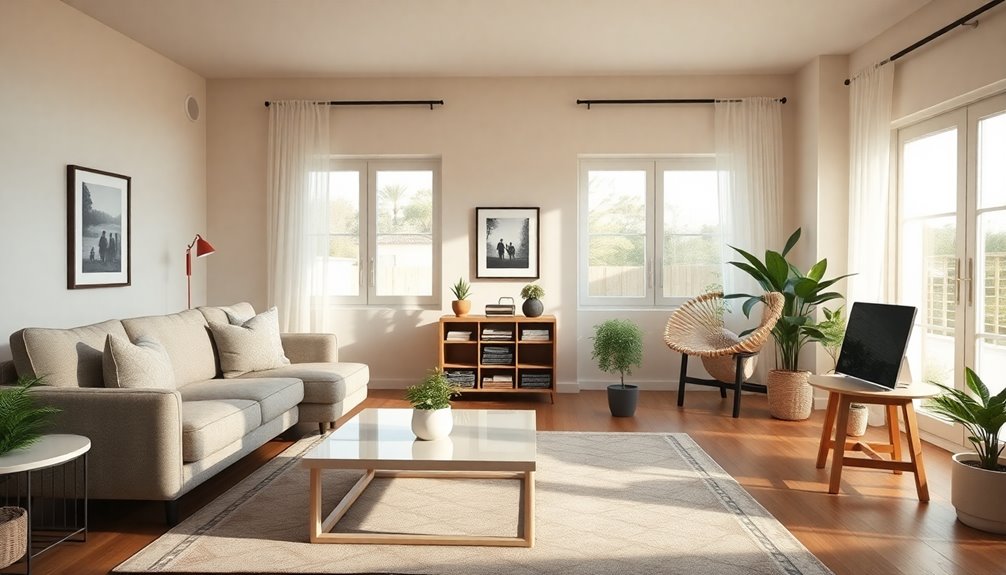
Smart home technology can really simplify your daily routine.
With voice-activated assistance, you can control lights and other devices without lifting a finger, making life a bit easier.
Automatic lighting solutions also guarantee you never walk into a dark room again, enhancing both comfort and safety.
Voice-Activated Assistance
Voice-activated assistance is revolutionizing how seniors interact with their homes, making daily tasks easier and more manageable.
With smart home technology, you can control various devices using simple voice commands, enhancing convenience and accessibility. This technology can help ease your daily routine and maintain your independence.
- Control lights, thermostats, and security systems hands-free
- Call for emergency services without reaching for a phone
- Set medication reminders and appointments
- Customize voice recognition for better understanding
- Make hands-free calls and send messages to loved ones
Embracing voice-activated assistance not only simplifies your life but also connects you with family and friends, so you can enjoy the benefits of modern living while staying safe at home.
Automatic Lighting Solutions
As you navigate your home, automatic lighting solutions can make a significant difference in your safety and comfort.
Lighting is critical, especially for older adults, as it helps prevent falls in entryways and high-traffic areas. Motion-sensor lights illuminate your path immediately, enhancing safety.
Plus, smart lighting systems can adjust brightness levels throughout the day, catering to the changing needs of aging eyes. Voice-activated controls allow you to operate lights effortlessly, promoting independence for those with limited mobility.
Integrating these smart solutions with home security systems guarantees lights turn on during emergencies or unusual activity, adding an extra layer of safety.
With customizable timers and remote controls, you or your caregivers can easily manage lighting needs, supporting your independence.
Adaptable Bathroom Designs
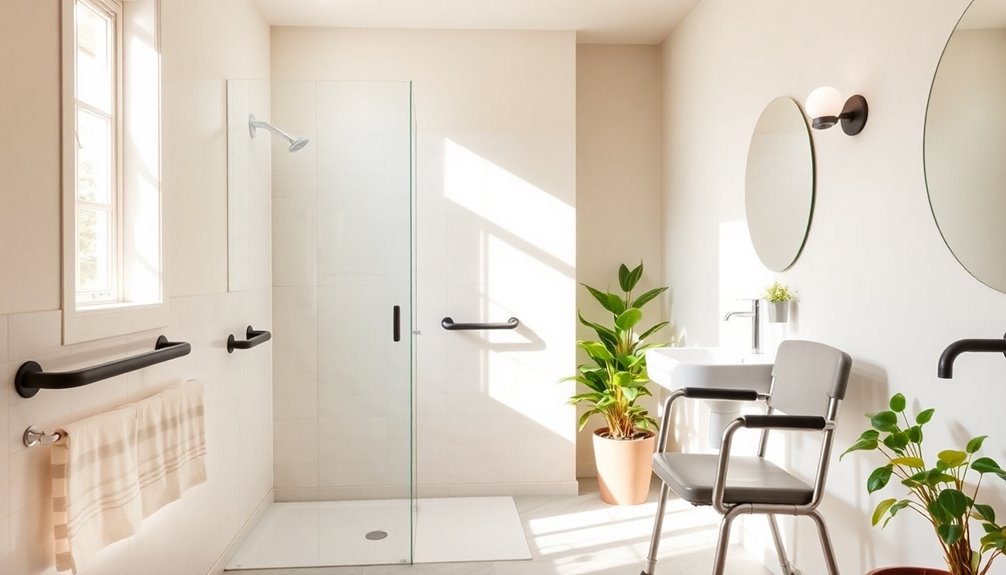
When designing a bathroom for elderly users, it's crucial to prioritize safety and accessibility without sacrificing style. Adaptable bathroom designs should focus on practical features that enhance comfort and reduce risks.
Consider these key elements:
- Curbless showers with handheld showerheads for easy access
- Strategically placed grab bars near the shower and toilet
- Non-slip flooring options, like textured tiles or cork-layered vinyl
- Raised toilets for easier sitting and standing
- Adjustable-height sinks and counters for various mobility levels
Frequently Asked Questions
How to Make a Home More Senior Friendly?
To make your home more senior-friendly, start by incorporating universal design features like lever-style door handles and no-step entrances. Consider adding non-slip flooring and well-placed grab bars in bathrooms to enhance safety without compromising aesthetics. Moreover, you can blend functionality with elegance by choosing stylish home decor for seniors that echoes personal taste while promoting ease of use. Soft lighting and clear pathways will further create a warm and inviting atmosphere that caters to the needs of older adults.
Improve lighting with bright, glare-free fixtures and motion-sensor lights to enhance visibility.
In bathrooms, add grab bars and non-slip flooring for safety.
Update your kitchen with lower countertops and pull-out shelves to promote independence.
If your home has multiple levels, consider installing stairlifts or elevators to ease movement between floors.
What Is the Most Desirable Home Design for Aging in Place?
So, you think designing a home for aging in place means putting a rocking chair in the corner? Think again!
The most desirable design is all about accessibility. You want no-step entrances, wider hallways, and lever-style door handles for easy movement.
Don't forget about bathrooms with grab bars and curbless showers.
And, of course, bright lighting is a must.
Make it functional, and you'll have a stylish haven that caters to everyone, including you!
How to Design a House for the Elderly?
When you design a house for the elderly, focus on accessibility and safety.
Start by widening hallways and doorways for mobility aids. Install grab bars in bathrooms and stairways for support.
Make certain the lighting is bright and glare-free, especially in high-traffic areas. Use slip-resistant flooring and minimize thresholds between rooms to prevent tripping.
Finally, create convenient entryways with landing spots for smooth changes from outside to inside.
How to Design for Elderly People?
Imagine walking into a sunlit room, where every
Conclusion
So, you might think creating an elderly-friendly home means sacrificing style for safety. Ironically, the trend is to blend both seamlessly. With non-slip floors and inviting colors, you can make your space a haven that's as trendy as it is practical. Who knew that incorporating grab bars could also mean adding a touch of modern design? Embrace these decor trends, and you'll find that a safe home can be the chicest place to age gracefully.
